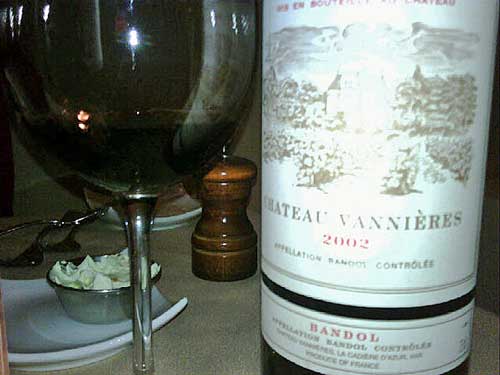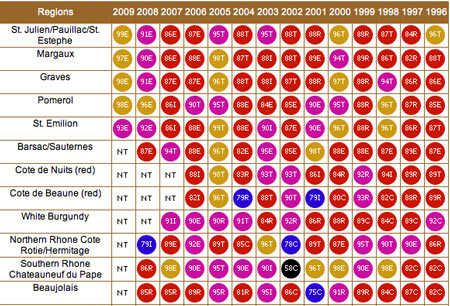VintageTexas ‘Cyclopedia of Wine: Vintage Charts
Vintage refers to the annual grape harvest and to the wine made from those grapes. In general, every year is a vintage year and all wines are vintage wines except if they are made with a blend of grapes from more than one vintage.
The concept of vintage is actually a recent development as for thousands of years the wines from each vintage were consumed young likely before the next vintage took place. These young wines were generally considered superior and carried a cost premium over older wines that were more likely to spoil.
The concept we now have whereby there is a distinction between vintages and the possibility of wines gaining benefits from aging was initiated in the late 1700s with the use of the glass bottle as the container of choice and the use of cork stoppers. In consort, these developments worked together to more effectively exclude air and protect the wine from deterioration during transport and aging.
The use of the term “vintage wine” as a term that denotes quality or excellence is generally meaningless when applied to table wines since. Every wine made from a single year’s grapes is in essence a vintage wine. In the case of Vintage Port or Vintage Champagne, the term vintage signifies that the wine was made from selected lots of wine from a single year of particular merit or distinction, rather than made from a blend of wine from multiple years.
I recently had a very interesting experience showing the limits of vintage charts in trying to assess wine quality and predict a tasting experience. I was having dinner with my wife at Le Mistral (www.lemistralhouston.com), a French restaurant in Houston, Texas. Besides enjoying the company of my lovely wife in combination with some fine French cuisine, something we both like immensely, I was also interested in having another palate calibration moment. See previous post:
Guilty As Charged. Texas WineSlinger Admits, “I Drink Foreign Wine” https://vintagetexas.com/?p=1864
I engaged Mistral co-owner, Sylvain Denis, in a conversation about a wine selection. I was interested in a Mourvèdre experience…a Bandol experience, something with age and developed qualities. Sylvain like his brother, Chef David, was born and raised in the Provence region of France, in the French Riviera town of Le Revest les Eaux, not far away from the area of Bandol AOC. What better source for the inside information on the wines of Bandol, its producers and the qualities of its vintages?
After I conveyed my specifications to Sylvain, he asked me to wait a moment while he went back to check his cellar to see what he could fine. After a short interlude, Sylvain returned and presented his selection: Chateau Vannières. Then, he said, “It’s a 2002 vintage, not the best, but this wine is from one of the top producers in Bandol.”
Now came the moment of fear and trust. I thought to myself, “2002, that’s the year of harvest rains and floods known far and wide as the possible the worst vintage in the modern history of Bandol AOC!”
In fact, if you check the celebrated vintages charts from the Wine Spectator and the affable yet very critical Robert Parker (See the lone black circle on the Robert Parker 2010 Vintage Chart shown above), you will see the dismally low ranking of the 2002 vintage in the region of the southern Rhone, just a stone’s throw away from the more easterly Bandol. This information would have scared off most wine enthusiasts. But, after a few more encouraging words from Sylvain based on his knowledge of Bandol, and a his willingness to pour and taste the wine and advise as to its worthiness for our dinner accompaniment, I said, “Let’s go for it!”
Sylvain slowly decanted the wine and we tasted it in unison. It was an acceptable wine with no flaws, not diluted, but it was still a bit slight on the nose. However, over the next few minutes while we talked and especially after about thirty minutes in the glass decanter, the wine was in full bloom. Deep dark berries turned to cassis, and smoky nuances morphed to a room full of fine cigars. This experience was supported by earthy undertones of a forest floor, crisp citrus-like acidity, and the firm tannic grip characteristic of the finer wines of Bandol. There was nothing that this wine left for disappointed.
This tasting experience illustrated a wine tasting adage that I learned long ago: In a bad year, select the best chateau you can afford. In a poorly rated vintage, such wines will provide an exceptional tasting experience, often at an affordable price, making them a great value. Though, the corollary to this adage is: Don’t wait too long as their longevity will be limited. The wines of Bandol are noted for their exceptional longevity of 15, 30 and even 50 years, if not more. So, in this case, we were probably safe to expect the wine to show well eight years after its vintage date. In fact, the wine probably had about five plus more years to give.
So, please remember that vintage isn’t everything, but use it as a guide. Vintages and vintage ratings are of only qualitative benefit in wine selection. Keep in mind that vintage charts are a guide and augment them with trust in your knowledge and experience, or the advice of an informed local as I did at Le Mistral.
Wine selection is for the brave of heart or for those that have credible information from whatever source you can get it!



Very true, we had wonderful tasting experience with Haut Brion on “Bad vintages” …
On the same vintage other Chateau, not so much …
The Rule of Rules: Screw Vintage Charts, know someone local who drinks the
wine.